Scientific Name
Aquilaria malaccensis Lam.
Synonyms
Agallochum malaccense (Lam.) Kuntze, Aloexylum agallochum Lour., Aquilaria agallochum (Lour.) Roxb. ex Finl., Aquilaria moluccensis Oken, Aquilaria secundaria Rumph. ex DC., Aquilariella malaccensis (Lam.) Tiegh. [1]
Vernacular Name
| Malaysia | Tengkaras, karas [2], gaharu [3] |
| English | Agar wood, malayan aloeswood, malayan eaglewood [2], wood of gods, aloeswood, aloewood [4] |
| China | Chen xiang, chen hsiang, mi hisiang [4] |
| Indonesia | Gaharu, kikaras (Sundanese); mengkaras (Sumatra) [2][4] |
| Myanmar | Agar [2][4] |
| Vietnam | Tr[aaf]m h[uw] [ow]ng [2][4] |
| Japan | Jinkoh [4] |
| France | Bois d’aigle, calambac, calambour [2]. |
Geographical Distributions
Aquilaria malaccensis occurs from north-eastern India (Bengal, Assam) through Burma (Myanmar) (Tenasserim) to Peninsular Malaysia, Sumatra, Bangka, Borneo and the Philippines (Luzon). [2] A. malaccensis is commonly found in primary and secondary forest, mainly in plains but also on hillsides and ridges up to 750 m altitude. It is scattered, in Peninsular Malaysia and north-eastern India at a density of about 2.5 trees/ha. In north-eastern India it occurs up to 1000 m altitude, but grows best in undulating terrain from 200-700 m. It thrives with an annual rainfall of 1500-6500 mm, a mean annual maximum temperature of 22-28°C and a mean annual minimum temperature of 14-21°C. It is found in wet-evergreen and evergreen forest and more rarely in semi-evergreen forest. This plant prefers heavy soils developed from gneiss and other metamorphic rocks, but it also grows well on sandy loams developed from sandstone. [2] Traditionally, A. malaccensis is indiscriminately collected from the wild, thus threatening the plant population. Efforts are currently being made to cultivate A. malaccensis and inoculate the plants chemically and organically to stimulate and enhance the production of the resinous hardwood. [5][6]
Botanical Description
A. malaccensis is a member of the family Thymelaeaceae. It is a tree that reach up to 20(-40) m tall, with its bole up to 60 cm in diameter, usually straight but sometimes fluted. Buttresses are up to 2 m high. The bark is smooth and whitish. The branchlets are slender, pale brown, covered with soft short hairs or nearly devoid of hairs. [2]
The leaves are simple, arranged alternate and supported by 4-6 mm long stalk. The blade is elliptical-oblong to oblong-lance-shaped between 7.5-12 cm x 2.5-5.5 cm. It is papery to nearly leathery texture, hairless but sometimes covered by soft short hairs and nearly devoid of hairs beneath. It’s shiny on both surfaces. Base is acute, attenuate or obtuse while apex is acuminate with acumen up to 2 cm long with rather irregular veins in 12-16 pairs. The veins are often branched, elevated and distinct beneath, curving upward to the margin, plane or obscure on the top surface. [2]
The inflorescence is terminal, arising from axils or supra-arising from axils, sometimes from two nodes umbel, usually branched into 2-3 umbels, each with about 10 flowers supported by 5-15 mm long stalk. The 3-6 mm long pedicel is slender. [2]
The flowers are 5-merous, bell-shaped, 5-6 mm long, green or dirty yellow with scattered soft short hairs on its outside. The floral tube is nearly hairless on the inside, distinctly 10-ribbed and persistent in fruit. The 5 sepal lobes are egg-shaped-oblong, 2-3 mm long, almost as long as the tube. It is abruptly bent and lined with densely soft short hairs within. The 10 petal-like appendages are inserted at the throat of the tube, oblong or slightly egg-shaped-oblong, about 1 mm long. It is slightly incurved and dense with long soft hairs. There are ten 1.2-2 mm long filamentous stamens emerging from the throat of the tube. The anthers are linear and obtuse with the pistil included. The 1-1.5 mm long ovary is ovoid, 2-celled with dense soft short hairs. The pistil style is obscure with the headed stigma. [2]
The fruit is a dorsal suture capsule, reverse egg-shaped solid object or reverse egg-shaped solid object-cylindrical that is 3-4 cm x 2.5 cm. It is usually compressed and covered with soft short hairs or nearly devoid of hair. Its base is wedge-shaped while the apex is rounded. The wall of ripened ovary is woody. [2]
The 10 mm x 6 mm egg-shaped seed includes a 4 mm long beak dense with red hair. It bears an appendage that is as long as the seed, twisted from the base, tail-like and covered with soft short hairs. Seedling germinates above ground. [2]
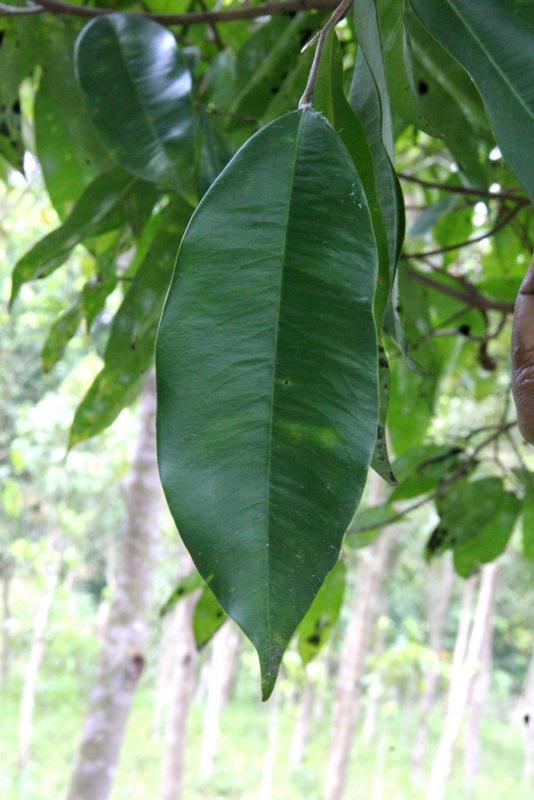
Cultivation
Cultivation
Soil Suitability and Climatic Requirement
A. malaccensis is commonly found in primary and secondary forests, ranging from the plains and on the hillsides up to 750 m in altitude. It grows best under wet evergreen and evergreen forests and rarely found in semi-evergreen forests. The heavy mineral soils are highly preferred even though it can also grow well on sandy loam soils. It requires an annual rainfall of 3000-5000 mm with the temperature of 23-300C. [5]
Field Preparation
Land Preparation
Prior to planting, normal field operations such as land clearing, disc ploughing and rotovation are to be conducted to eradicate weeds and improve the soil structure. GML (ground magnesium limestone) at 100 g/planting hole are applied to increase the soil pH to the required level. TSP (triple super phosphate) at 50 g/hole was applied as the basal fertiliser. The size of a planting hole is approximately 30 cm x 30 cm x 20 cm. The field drainage system should be established in areas where waterlogged is a threat. [5]
Production of Planting Materials
The plant can be propagated by seeds. The seeds to be used should be obtained from fully matured fruits. The seeds are short-lived. Thus only the freshly collected seeds are used. The seeds start to germinate at 3-4 weeks after sowing. These seedlings are then transferred to the polybags at about 2 weeks after germination. They are then kept under about 50% shade in the nursery and ready for field plating when it grows to about 60 – 80 cm high.[5]
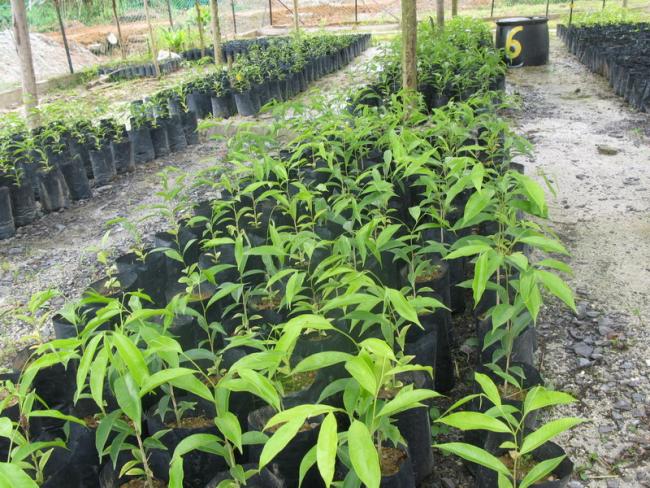
Field Planting
The recommended planting distance for A. malaccensis is about 3 m x 3 m. This will give the population density of about 1,100 plants/ha. Planting should be done at the beginning of the planting seasons to minimise the transplanting shock. Organic mulch such as dried leaves can be applied to conserve the soil moisture. [5]
Field Maintenance
Fertilisation
Two types of fertilisers are recommended that is chicken dung and inorganic fertiliser, NPK (15:15:15). Chicken dung at the rate of 15 kg/plant is given when planting followed by yearly application of about 5 kg/plant for the next 2 years. The inorganic fertiliser is given at 200 g/plant for the second year, 300 g/plant for the third year and subsequently at 500 g/plant from the fourth year onwards. [5]
Weed Control
Proper weed control within 50 cm around the planting point is very important to ensure there is no competition for nutrition and space between the weeds and the plants. It can be done manually by using hoe or by spraying with contact herbicides. Use of organic mulch can help to reduce weeds around the planting point. [5]
Water Management
For large scale planting, application of supplementary irrigation is not practicable. However, to minimize planting shock, field planting should be carried out at the onset of raining seasons. The use of organic mulch such as dried grasses or lalang can help to conserve soil moisture at planting. [5]
Pest and Disease Control
Currently, there are no serious pest and disease problems in the commercial production of A. malaccensis. However, for the early stages of crop growth, heavy infestation with scale insects or grasshopper can affect the vigour of the crop. Scale insects can be controlled by practicing good sanitary practices. [5]
Harvesting
The plants that have been inoculated are ready for harvesting on the 5thto 6thyear planting. At this stage the diameter of the stem is about 25 cm.A. malaccensisare harvested by chopping the outer bark usingmacheteoraxe. Harvesting is usually carried out at 3-5 months intervals. The harvested inoculated barks or core are then sent for further processing and distillation of the essential oils.[5]
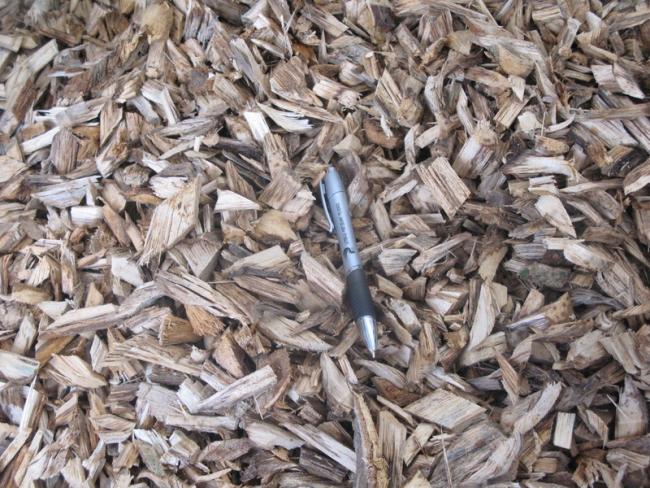
Postharvest Handling
The post harvesting activities before distillation process includes chopping of the bark into smaller pieces, grinding and soaking of the grounded materials in water. One hectare ofA. malaccensiscould produce about 500 kg of extracted oil. [5]
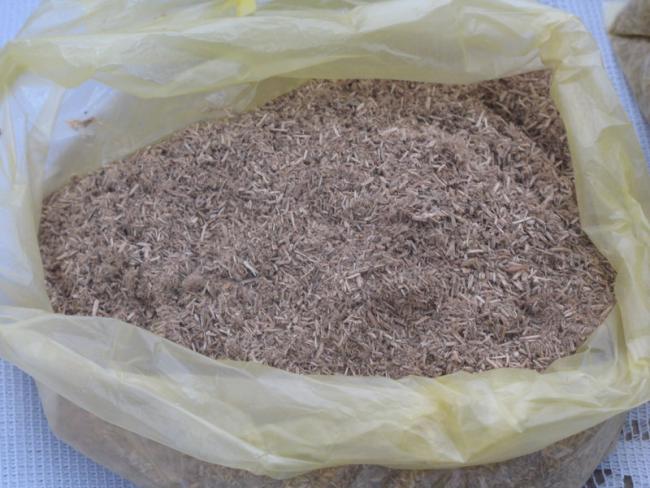
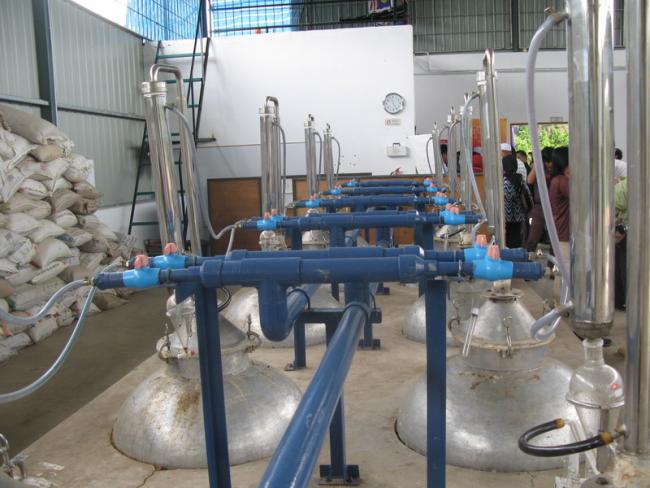
Estimated Cost of Production
The total production cost for a 6 year old crop is estimated at RM 95,000/ha. The main components of the cost are the planting materials, land preparations, agricultural inputs and labour for crop maintenance. Thus, for a total yield of yield 500 kg/ha, the average cost of production for a kilogram of the oils produced is RM 190. The cost of production was estimated based on the current inputs cost during writing of this article. [5]
Chemical Constituent
No documentation
Plant Part Used
No documentation
Traditional Use
In Malaysia, A. malaccensis mixed with coconut oil is used as a liniment, and its concoction, to treat rheumatism and other body pain. A. malaccensis is also prescribed for jaundice, smallpox and for various abdominal complaints, treatment of dropsy, heart palpitation and as a tonic during pregnancy, after childbirth and for diseases of female genital organs. The oleoresin obtained from steam distillation of the wood is used in making the famous “attar” commonly used by Muslim to lace prayer clothes. Its uses range from a general perfume to an important religious occasion by Muslims, Buddhists and Hindus. Incense sticks are also used in prayer during festivals and ceremonies by Indians and Chinese. [5][6]
Preclinical Data
No documentation
Clinical Data
No documentation
Poisonous Management
No documentation
Line drawing
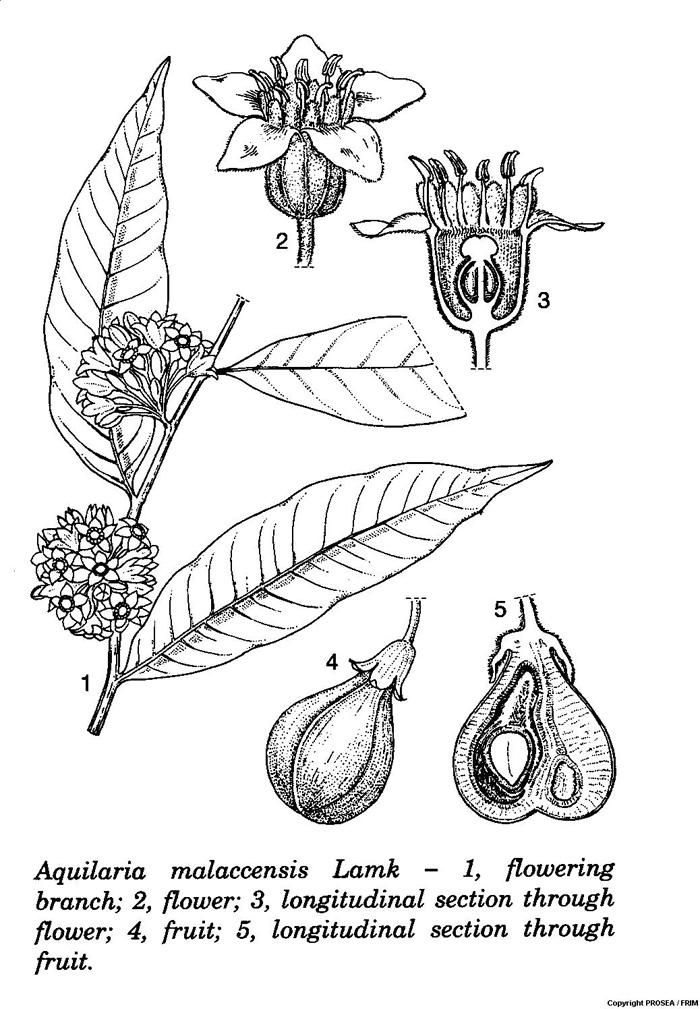
References
- The Plant List. Ver1.1. Aquilaria malaccensis Lam. [homepage on the Internet]. c2013 [updated 2012 Apr 18; cited 2015 Apr 07]. Available from: http://www.theplantlist.org/tpl1.1/record/tro-32000450
- Chung RCK, Purwaningsih. Aquilaria malaccensis Lamk. In: Oyen LPA, Nguyen Xuan Dung, editors. Plant Resources of South-East Asia No. 19: Essential-oil plants. Leiden, Netherlands: Backhuys Publisher, 1999; p. 64-67.
- Herbal Medicine Research Centre, Institute for Medical Research. Compendium of medicinal plants used in Malaysia. Volume 1. Kuala Lumpur: HMRC IMR, 2002; p.55.
- Quattrocchi UFLS. CRC World dictionary of medicinal and poisonous plants: Common names, scientific names, eponyms, synonyms, and etymology (5 Volume set). Boca Raton, Florida: CRC Press; 2012. p. 347
- Department of Agriculture Peninsular Malaysia. Panduan lengkap penanaman gaharu. Kuala Lumpur: Department of Agriculture Malaysia; 2010.
- Burkill IH. A dictionary of the economic products of the Malay Peninsula. Volume 1. London: Published on behalf of the governments of the Straits settlements and Federated Malay states by the Crown agents for the colonies; 1935.


